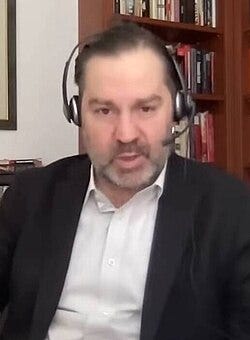I've been reflecting upon the 'movie' I've been watching - the recent Venezuela caper added on to everything else with DaTrumpster - it's very simple:
Government, Religion, Politics and Culture
Labels
- Politics (8686)
- Government (8355)
- Political Correctness (6077)
- Culture (5116)
- Fedonomics (5016)
- Education (3967)
- Mentoring (3562)
- ChristianActionProject (3219)
- CultureEducation (1575)
- Immigration (1555)
- Religion (900)
- Homeschooling (453)
- CAP Lessons (66)
Saturday, January 10, 2026
Does DJT Imagine He's Playing JW? But Who's Writing DaScript?
Cathedra Book 3: Pascal's PENSÉES - Castalia Library
The third book in the Castalia Cathedra series of leatherbound Christian titles is PENSÉES by Blaise Pascal.
THE FUNDAMENTALS OF THE CHRISTIAN RELIGION
... Men blaspheme what they do not know. The Christian religion consists in two points. It is of equal concern to men to know them, and it is equally dangerous to be ignorant to them. And it is equally of God’s mercy that He has given indications of both..
And on this ground they take occasion to revile the Christian religion, because they misunderstand it. They imagine that it consists simply in the worship of a God considered as great, powerful, and eternal; which is strictly deism, almost as far removed from the Christian religion as atheism, which is its exact opposite. And thence they conclude that this religion is not true, because they do not see that all things concur to the establishment of this point, that God does not manifest Himself to men with all the evidence which He could show.
But let them conclude what they will against deism, they will conclude nothing against the Christian religion, which properly consists in the mystery of the Redeemer, who, uniting in Himself the two natures, human and divine, has redeemed men from the[Pg 153] corruption of sin in order to reconcile them in His divine person to God.
The Christian religion, then, teaches men these two truths; that there is a God whom men can know, and that there is a corruption in their nature which renders them unworthy of Him. It is equally important to men to know both these points; and it is equally dangerous for man to know God without knowing his own wretchedness, and to know his own wretchedness without knowing the Redeemer who can free him from it. The knowledge of only one of these points gives rise either to the pride of philosophers, who have known God, and not their own wretchedness, or to the despair of atheists, who know their own wretchedness, but not the Redeemer.
And, as it is alike necessary to man to know these two points, so is it alike merciful of God to have made us know them. The Christian religion does this; it is in this that it consists.
Western Money to Communist Russia, by Marcus Schultze - The Unz Review
Many generations have grown up hearing the statements made in schools, universities and the media that the capitalist West and the communist East were real enemies during the 20th century, and opposing sides during the so-called Cold War.
However, several courageous and insightful researchers have proven that the confrontation between the capitalist West and the communist Soviet Union and its allies in the 20th century was largely just apparent. An outstanding work has been done by Dr Antony C. Sutton’s research, which can be taken together as follows:
Communist Russia would not have survived without the help of the US and its allies after the bolshevik coup d’etat in 1917 and long after that.
Dr Sutton’s monumental work “Western Technology and Soviet Economic Development”[1] and its condensed version “National Suicide: Military Aid to the Soviet Union”[2] highlight a strong and substantial support of Western economic and banking forces to the Soviet communist movement and regime.
During many years, doctor of economics Antony C. Sutton (1925-2002) conducted his ground-breaking research and discovered thousands of documents that prove something, which the conventional historians have hard time to digest. He showed that the communist regime in Russia was wholly dependent on capitalist aid and trade with the US and its allies.
According to Dr Sutton, by far the most significant factor in the development of the Soviet economy has been its absorption of Western technology and skills. His primary sources for data were the U.S. State Department Decimal Pile and the German Foreign Ministry Archives, supplemented by journals in half a dozen languages from a dozen countries, especially the journals published by Soviet trade representatives abroad.
Historian Richard B. Spence has also researched the subject and highlighted the “achievement” of the communists – in just a few years after 1917, they had expropriated the Russian economy from its former owners, run it into the ground, and stripped the country of gold and valuables, most of which ended up in the West – the lion’s share in America. Russia had been turned into an economic wasteland, and foreign capitalists were now being invited to rebuild it.[3]
Historian Sean Mcmeekin has described that bolsheviks opened negotiations with both Germany and the Entente powers over the possibility of commercial concessions in Russia already in the first half of 1918. The concessions game was serious: without some investment in Russia’s economy, the bolsheviks would soon find themselves ruling over a barren wasteland.[4]
In fact, Western aid to the Bolsheviks began already during the First World War. This will be the subject of a separate analysis to be published soon.
These facts have been systematically hidden and silenced by the authorities and business circles. Every serious seeker who strives to understand the happenings in our present civilisation should reflect upon the motives and backgrounds of such actions.
The Idiocy of Using a $200 Billion Navy To Enforce a 140× Cocaine Premium - David Stockman
In any event, the fatality rate among cocaine users purely from cocaine is just 0.1% or the same as alcohol. Yet due to Nixon’s long-running misbegotten War on Drugs, we spend billions each year trying to eradicate it—a pointless effort that now includes even the mobilization of the US Navy against fishing boats.
But here’s the thing. Using $40 billion carrier battle groups to blow-up cocaine-transiting speed boats is simply the stupidest, most irrational action ever conceived on the banks of the Potomac, and there is surely plenty of competition for that honor.
The reason is straight forward: Namely, interdiction and destruction of supply only drives up the price and drastically so—thereby making the illicit business of growing, shipping and distributing cocaine all the more profitable. In turn, this also means that the illegal cartels which distribute it are capable of spending whatever it takes to counter-act law enforcement and to compensate for the loss of product due to interdiction.
Stated differently, the idiots behind Prohibition—from alcohol to cocaine and heroin—believe that they can win by defying the law of supply and demand.
They most surely cannot.
The only thing supply destruction actually accomplishes is to massively increase the revenue of the drug cartels and their ability to maintain ever larger armies of ever more violent operatives to conduct their insanely profitable businesses.....
Stated differently, the prohibition cost amounts to more than $53,000 per pound.
What does that $53,000 per pound cost of law enforcement and prohibition in the retail price of coke really fund?
Well, violent criminal syndicates. That’s what!
And yet and yet. The Donald is compounding the insanity by mobilizing $40 billion Naval carrier battle groups to make, well, a lot more totally unnecessary crime on the streets, byways and communities of America.
Why Kill for Trump? - (This is specifically addressed to my grandsons with copies to their parents. - CL)
This is an update on a previous article I wrote for LewRockwell.com. I believe that message is even more relevant today. I hope that young men—and those who influence them—act today......
Events turn quickly. No one can say that war and draft are imminent. Nevertheless, no one can say they aren’t. So it makes sense to be prepared for an event that could happen tomorrow.
When drafted, you can appeal to your local draft board as either an objector to combatant military service (Class 1-A-O) or to all military service (Class 1-O). To win your appeal, you will have to satisfy the board that you meet three criteria: opposition that is based on religious training or belief, ethical or moral belief, and a demonstration that those beliefs are sincere.
It will be your board that initially decides your fate. There are means to appeal to two additional levels, but it would be best to settle this matter as soon as possible. Though your board consists of five members from your local area (likely your county), there are various opinions and beliefs that exist in any area, no matter how ideologically similar that area may appear on the outside.
You must ask yourself who would serve on a local draft board. Would they likely believe in military service? How would they feel about someone objecting, even if that objection were based on sincerely held beliefs? Those questions cannot be answered for your specific board, at least until you stand before them and hear their questions and comments.
One thing you can do today to help your appeal is to write down your objections to war and send that in a certified letter to yourself. Do not open it until your hearing. Another action you can do is talk to your pastor or other mentors or close friends. Express your views and ask them to confirm your objections in a certified letter to you. Also, ask if they would be willing to be one of the three witnesses you can have at your hearing.
Though there are certainly many other actions you can take, those above will provide evidence that your views on war are sincere and deeply held.
If killing will rot your soul, act today.
The Death of Europe, by Hans Vogel - The Unz Review
But wait, you might have noticed that in some parliaments the chairman has prohibited the use of certain terms and words. In the Dutch Parliament the word “omvolking” (population replacement) is strictly forbidden. Use of the term may lead to an MP’s suspension. Yet what has been going on in Europe since the mid-1970s is precisely that: population replacement. Since government control in Europe has become much stricter over the years, it is obvious that few things happen in Europe without the state knowing about it. On the contrary, most things happen because the state wants it.
Just look at the Great Covid Show, look at “Climate Change” and at the official policies that we are told help to fight it. Listen to all those warmongers in Germany, France and everywhere else, shouting that “the Russians are coming.” No one can deny that, indeed, the native Europeans are being replaced by Africans and Asians. In the EU, with over 450 million inhabitants, there are dozens of millions of blacks and Muslims, few of them with any respect for, or even true interest in traditional European culture. Many of them cannot even properly speak, let alone read, the language of the European country where they hold citizenship. In Brussels, three quarters of local people under 20 are not European. In Vienna, the majority of grade school students is foreign, most of them Muslims. How ironic that in 1689 the Turks were narrowly prevented from conquering Vienna and making it au Muslim city, whereas today the youth of Vienna is largely Muslim.
How Trump’s Oily Dreams May Collapse in a Venezuelan Dark Pit - (Showtime is over - REALITY always intrudes. - CL)
Conclusion: “Converting Venezuela’s Chinese-built oil sector into an American one would take three to five years, minimum.”
Financial analyst Lucas Ekwame hits the major points. Venezuela produces superheavy oil as thick as tar. It doesn’t just flow; it needs to be melted to reach the surface, and after extraction, it hardens again, requiring diluent: no less than 0.3 barrels of diluent need to be imported for each exported barrel.
Compound it with Venezuela’s energy infrastructure shaped by China and at the same time suffering years of American sanctions, even worse than over Iraq in the early 2000s, and neo-Caligula’s faulty oil “strategy” becomes obvious.


